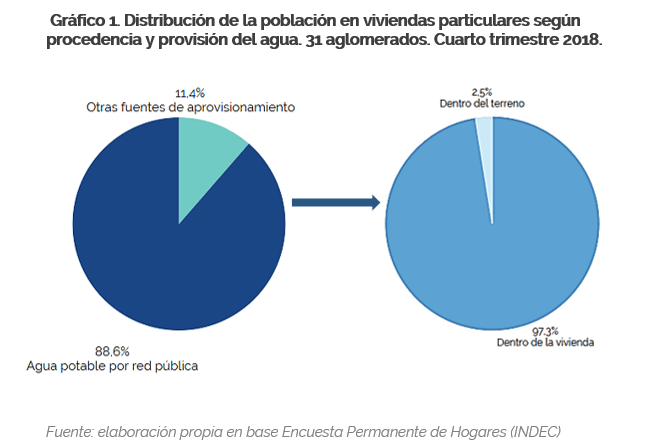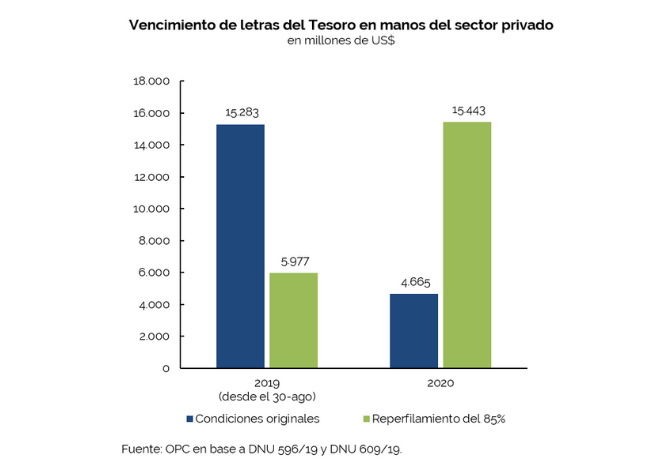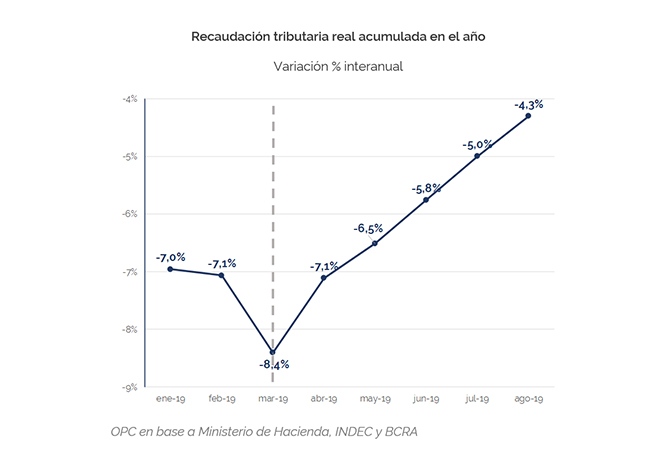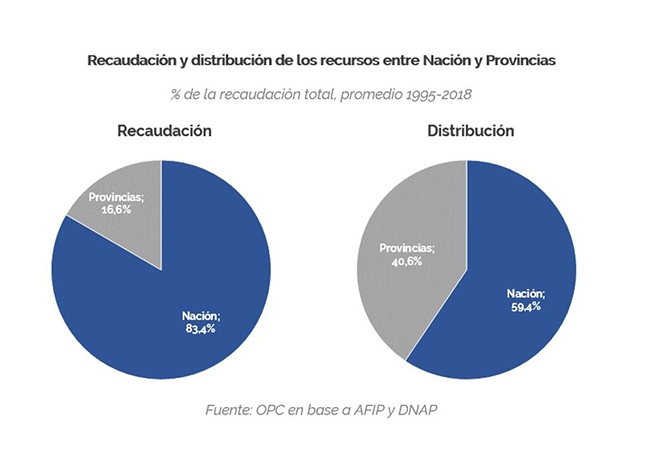
by Nicolas Perez | Sep 23, 2019 | Sustainable Development Goals
This is the first in a series of reports to be prepared by the Argentine Congressional Budget Office (OPC) to analyze Argentina’s progress in achieving the United Nations Sustainable Development Goals from a budgetary perspective. As there is no international consensus on the SDG budget evaluation methodology, the OPC used its own tool.
The focus is on SDG 6, Clean Water and Sanitation, and SDG 7, Affordable and Clean Energy. In accordance with the provisions of the current year’s Budget Law, the actions to be carried out by Argentina related to the SDG 6 will require AR$25.48 billion, while those related to energy issues have an initial appropriation of AR$212.01 billion.
By 2023, Argentina has committed to universal access to drinking water service through the public network, which would imply, according to INDEC population projections, the addition of 9.5 million people. As for the sewage network, the commitment to universalization was set for the year 2030, bringing the number of citizens to be included up to that year to 26.4 million.
Argentina adopted three targets linked to SDG 7. That of “universalizing access to affordable, reliable and modern energy services” implies meager increases in coverage, since according to the latest available data 98.8% of households had access to electricity and 97.2% to clean fuels for cooking; that of “significantly increasing the proportion of renewable energy” implies using 10.9% of green sources to supply total consumption this year; the most challenging is to increase energy efficiency (total energy vs. GDP), changing the trend shown in recent years.

by Nicolas Perez | Sep 12, 2019 | Public Debt Operations
- With the financial markets facing an episode of extreme volatility, the Executive Branch announced in August a rescheduling of the maturities of Treasury bills held by institutional holders.
- The rescheduling reversed the maturity burden: under the original terms, 77% of the payments were to be made this year. But under the new schedule, 72% will be cancelled in 2020. Estimated maturities for 2019 are reduced by USD9.3 billion, but because of the extension of maturities, an additional USD1.47 billion of interest will accrue with respect to the original payment schedule.
- Placements of securities and loan disbursements for the equivalent of USD1.8 billion were recorded in August, mainly with transactions within the public sector.
- Principal and interest cancellations for USD17.06 billion were made during the month, of which 96% were for repayments of principal. The major amortizations for the month were the cancellation of bonds issued as collateral for repo transactions.

by Nicolas Perez | Sep 11, 2019 | Cost Estimates
Currently, national public policies on food and nutrition are implemented through the Food Policies and National Social Protection Plan programs, both of the Ministry of Health and Social Development, as well as through the Pro Bienestar program of the National Institute of Social Services for Pensioners and Retirees.
Two possible scenarios for the estimation of a fiscal cost arise from the Bill:
- if the increase is estimated based on the appropriations in force for the identified programs as of August 31, the cost would amount to AR$10.5 billion.
- If the increase is estimated based on the appropriations not executed in the identified programs as of August 31, the cost would amount to $4.06 billion.

by Nicolas Perez | Sep 10, 2019 | Budget Execution
The national government recorded primary and financial surpluses of AR$119.8 billion and AR$110.01 billion in August, which implies a substantial improvement over the fiscal outcome obtained in the same period of the previous year. Although largely due to the inflow of extraordinary funds from Central Bank profits, total resources recorded the highest rate of expansion so far this year (115.1%), while expenditures fell in real terms for the tenth consecutive month.
- Property income totaled AR$136.9 billion and accounted for 52.8% of the increase in resources.
- Expenditure increased 37.5% year-on-year (YoY), with economic subsidies (106.1% YoY) and capital expenditures (61.7% YoY) being the components with the highest increase.
- In the first eight months of the year, the cumulative financial balance was negative by AR$216.6 billion, recording, however, an improvement of 60.6% YoY in real terms.
- Budget execution level of total expenditures as of August 31 was 64.2% (64.6% as of the same date of the previous year), with the items economic subsidies and current transfers to the provinces standing out as the ones with the highest execution, with 70.5% and 71.3%, respectively.
- As a result of the economic measures adopted on August 14, an increase in expenditure of AR$39.89 billion is expected for the remainder of the year.

by Nicolas Perez | Sep 6, 2019 | Tax Revenue
National Public Sector revenues grew nominally in August compared to the same month of the previous year and, for the first time in over a year, recorded an increase in real terms, confirming the improving trend that had been outlined in previous months.
This situation is mainly explained by the boost given to tax collection by Export Duties and Wealth Tax, whose contributions exceeded inflation in the year-on-year comparison.
On the other hand, the main drop of the month was recorded in Social Security, because of the contraction of the wage bill and regulatory changes affecting contributions.
A total of AR$458.5 billion was collected in August, which implied a nominal year-on-year growth of 56.3%. The year-on-year variation was 48%.
It is estimated that the different fiscal measures announced by the Executive Power at the end of last month will have a cost of AR$86.9 billion for the remainder of the year.

by Nicolas Perez | Sep 6, 2019 | Tax Policy and Fiscal Federalism
The analysis of the fiscal relations of the Nation and the provinces between 1993 and 2018 reveals a significant increase in provincial own tax resources, as well as in transfers received from the central government: the federal states gained share in the allocation of total tax resources by virtue of agreements between jurisdictions and changes in the tax structure.
- Between 1993 and 2018, total tax burden increased by 9 percentage points, from 19.6% to 28.6% of GDP.
- The fiscal year 2015 was the one with the highest tax burden of the term 1993-2018, when it reached a maximum of 31.1% of GDP.
- Provincial tax resources increased from 3.4% of GDP between 1993 and 2001 to 5.3% between 2013 and 2018. This increase was surpassed by the increase in expenditures, partly financed by higher transfers from the central government.
- The percentage of own taxes in total resources went from a maximum of 82.3% (Autonomous City of Buenos Aires) to a minimum of 4.7% (Formosa).
- Transfers by Federal Co-participation and special laws went from 5% to 7.5% of GDP in that period and showed growth trend, except for the 2001-2003 term. But own resources moved along the same line, which does not necessarily imply greater provincial dependence on the central government.
- In the 2015-2018 term, only three provinces (the Autonomous City of Buenos Aires, the Province of Buenos Aires and Neuquén) had sufficient own resources to cover their expnediture on personnel.
Since 2003, there has been a sustained growth in automatic transfers from the national government.






